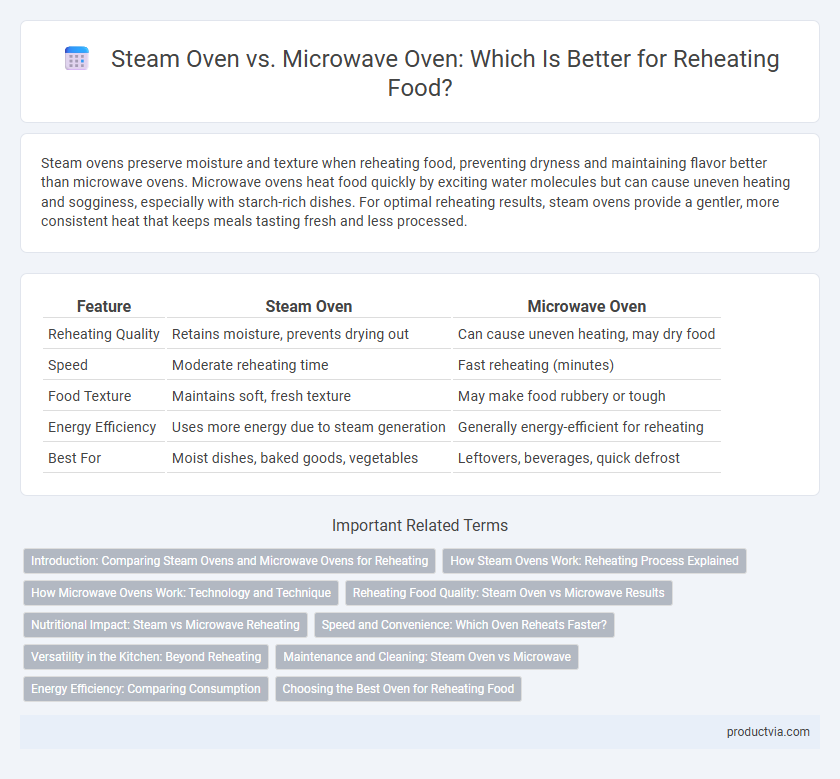Steam ovens preserve moisture and texture when reheating food, preventing dryness and maintaining flavor better than microwave ovens. Microwave ovens heat food quickly by exciting water molecules but can cause uneven heating and sogginess, especially with starch-rich dishes. For optimal reheating results, steam ovens provide a gentler, more consistent heat that keeps meals tasting fresh and less processed.
Table of Comparison
| Feature | Steam Oven | Microwave Oven |
|---|---|---|
| Reheating Quality | Retains moisture, prevents drying out | Can cause uneven heating, may dry food |
| Speed | Moderate reheating time | Fast reheating (minutes) |
| Food Texture | Maintains soft, fresh texture | May make food rubbery or tough |
| Energy Efficiency | Uses more energy due to steam generation | Generally energy-efficient for reheating |
| Best For | Moist dishes, baked goods, vegetables | Leftovers, beverages, quick defrost |
Introduction: Comparing Steam Ovens and Microwave Ovens for Reheating
Steam ovens reheat food by circulating moist heat, preserving texture and flavor better than microwave ovens, which use electromagnetic waves that can cause uneven heating and dryness. Microwaves excel at rapid reheating, making them convenient for time-sensitive meals, while steam ovens provide a gentler, more consistent warming process ideal for delicate dishes. Choosing between the two depends on whether speed or food quality is the primary priority for reheating.
How Steam Ovens Work: Reheating Process Explained
Steam ovens reheat food by circulating hot steam around the dish, maintaining moisture and preventing dryness during the heating process. This method ensures even temperature distribution, preserving texture and nutrients better than microwave ovens. Unlike microwave ovens that use electromagnetic waves to excite water molecules, steam ovens utilize saturated steam at controlled temperatures for gentle, consistent reheating.
How Microwave Ovens Work: Technology and Technique
Microwave ovens use electromagnetic waves at a frequency of about 2.45 GHz to agitate water molecules in food, generating heat through dielectric heating for rapid and even reheating. This technology allows microwaves to penetrate food up to several centimeters, speeding up the heating process compared to traditional convection or steam ovens. Unlike steam ovens that rely on moist heat, microwave ovens do not add moisture but instead excite water molecules directly, preserving texture while efficiently reheating leftovers.
Reheating Food Quality: Steam Oven vs Microwave Results
Steam ovens preserve moisture and texture during reheating, resulting in evenly heated food with minimal drying or sogginess. Microwave ovens heat food rapidly but often cause uneven warmth and can leave meats rubbery or vegetables mushy due to moisture loss. Studies show steam ovens maintain better flavor integrity and nutritional quality compared to microwaves when reheating various food types.
Nutritional Impact: Steam vs Microwave Reheating
Steam ovens preserve more nutrients during reheating by gently using moist heat, which reduces nutrient loss compared to microwave ovens that can cause uneven heating and nutrient degradation due to electromagnetic waves. Microwaves often lead to faster reheating but may diminish sensitive vitamins like vitamin C and B-complex more significantly than steam ovens. Using steam ovens for reheating maintains food's texture and nutritional quality, promoting better retention of antioxidants and minerals.
Speed and Convenience: Which Oven Reheats Faster?
Steam ovens reheat food by circulating moist heat, preserving texture and moisture but generally requiring 10-15 minutes, making them slower than microwave ovens. Microwave ovens use electromagnetic waves to excite water molecules, reheating food in 1-3 minutes, providing superior speed and convenience for quick meals. Consumers prioritizing fast reheating often prefer microwave ovens, while those valuing food quality may opt for steam ovens despite longer cooking times.
Versatility in the Kitchen: Beyond Reheating
Steam ovens offer superior versatility in the kitchen by not only reheating food but also steaming vegetables, baking, and slow cooking with precise moisture control. Microwave ovens primarily excel at quick reheating and defrosting but lack the ability to maintain food texture or perform complex cooking techniques. Choosing a steam oven enhances meal preparation options and improves overall cooking quality beyond simple reheating tasks.
Maintenance and Cleaning: Steam Oven vs Microwave
Steam ovens require regular descaling to prevent mineral buildup and maintain efficient steam generation, while microwave ovens need frequent wiping to remove food splatters and avoid odor retention. The steam oven's self-cleaning cycles often reduce manual maintenance efforts, contrasting with microwave ovens that rely heavily on manual cleaning to prevent grease and grime accumulation. Both appliances benefit from routine inspections of door seals and vents to ensure optimal performance and hygiene.
Energy Efficiency: Comparing Consumption
Steam ovens consume more energy than microwave ovens due to longer cooking times and the need to generate steam, but they provide evenly reheated food with moisture retention. Microwave ovens use electromagnetic waves to heat food quickly and with less energy, making them highly efficient for short reheating tasks. For energy-conscious users, microwaves often offer lower electricity consumption while steam ovens deliver superior food quality at a higher energy cost.
Choosing the Best Oven for Reheating Food
Steam ovens preserve food moisture and enhance flavor by reheating evenly without drying, making them ideal for maintaining texture and taste in leftover dishes. Microwave ovens offer rapid reheating with convenience but can result in uneven heating and dry spots due to their reliance on electromagnetic waves. Choosing the best oven for reheating depends on prioritizing speed versus quality, where steam ovens excel in preservation and microwaves in speed.
Steam oven vs Microwave oven for reheating food Infographic

 productvia.com
productvia.com